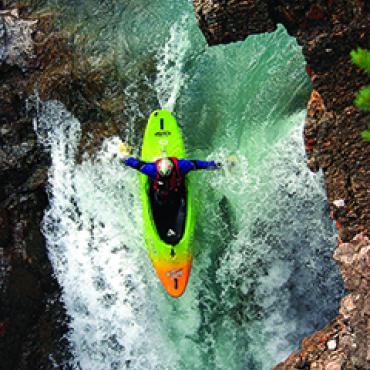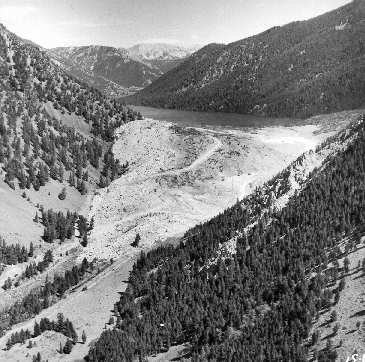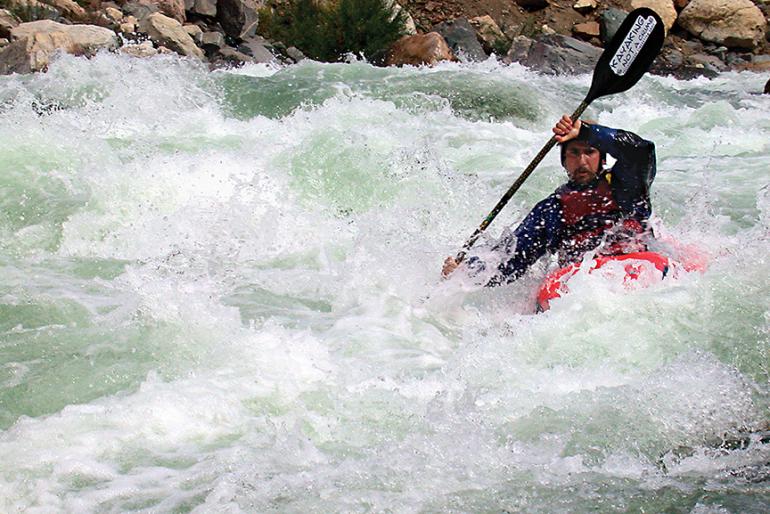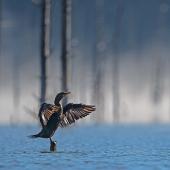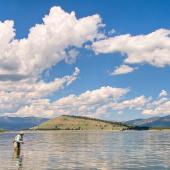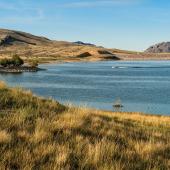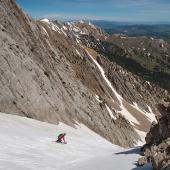Irresistible Change
A look at Quake Lake.
A salty fisherman, staggering to another haunt, pauses mid-weave. Cocking his head to the side, a puzzled eyebrow raised, he listens to the sudden lapping of waves rolling through the wharf to caress the broken shore of Puget Sound .In Banff, Alberta, a honeymooning couple part lips, their eyes darting toward the nervous chatter of china in the cupboard. Backcountry hikers in the heart of Utah, contemplating the infinite cosmos are instantly returned to earth by the abrupt, rhythmic breathing of the desert floor. A thousand miles to the Northeast, a cattle rancher works his jaw, palm outstretched and planted firmly on the ground. Slowly he rises from his haunches and looks deep into the western sky.
It is August 17, 1959. 11:37 PM. Millions of people are silenced and powerless. Stopped in their tracks or bolting upright in bed, all, for a moment, are awestruck by the sensation of the earth trembling beneath them. While most are left to concern and speculation, those unfortunate enough to be near the epicenter of this major earthquake— measuring 7.5 on the Richter scale—are facing the unimaginable. People throughout the Greater Yellowstone area are struggling to keep their feet with everything heaving and vibrating around them. The north shore of Hebgen Lake, quite near the major fault line, drops 19 feet, generating a series of large waves, known as a ‘seiche’. The waves slosh back and forth across the lake, eventually reaching a height of twenty feet, cracking the earth-filled dam and pulling many homes and cabins from their foundations into the turbid waters. Roadways crumble and bridges buckle as earth, water, and gravity rip and tear from all sides.
Eight miles below the Hebgen dam, at Rock Creek Campground, a tragedy is unfolding. An enormous section of the steep south wall of Madison Canyon has dislodged and is thundering down the mountainside. For those camped in the slide’s path, there is no hope or escape. Ninety million tons of rock and earth, reaching speeds of 100 miles per hour, sweep down and through the Madison River. Defying gravity, the slide charges a full 400 vertical feet up the opposite side of the canyon before the deafening roar finally begins to subside. Behind the impenetrable debris field, the Madison begins to pool up. The canyon is completely sealed. In the blackness of a dust-filled night, between the chaos at Hebgen and the cries of anguish at Rock Creek, a lake is born.
Six miles long, reaching depths of 190 feet, Quake Lake is an impressive, thought-provoking body of water. The eerie skeletal remains of the forest poking up from the lake bottom give the area the solemn respect it deserves. It is an enduring reminder that we are but small players in the Earth’s grand scheme, subject to the whims and change of unalterable natural forces. The lake itself boasts good fishing, canoeing, and some very interesting scuba diving opportunities in a dramatic setting.
At the northwest end of the lake, where the river begins cutting its tortured path through the debris field, lies a unique and demanding opportunity for the intrepid whitewater enthusiast. The clear waters begin to accelerate 50 feet back from the marriage of lake and river, pulling a kayak through the gate and rocketing down an intense section of Class IV-V whitewater known as Quake Attack. Dropping over 200 feet in a mere mile and a half, this section of the Madison is nothing short of a mug-chuckin’ bar fight from top to bottom. If you are contemplating a run down this section, set that bar stool down a second and lend me an ear. This run is a big step up from the pool-drop rapids of the Bear Trap or Yellowstone, and is of a completely different character than the Gallatin’s “Mad Mile”. There are few eddies and the entire mile and a half should be considered one long, nasty rapid. The rocks are like razors, lurking inches below the surface, and there have been more than a few close shaves here. Swimming is not an option.
That said, there is a large eddy to be found about 2/3 of a mile below the put-in on river left. This is just before the river bends right at the base of the main slide and charges through the infamous “S-Turn” (all this is clearly visible from the road), a solid and serious Class V drop well worth scouting and considering at length. This is the crux of the run and the reason most folks paddle here. The lines are numerous, though technical, and safety set-ups are marginal at best. Choose well… Legend has it that a local kayak shop owner has run the S-Turn clean while blindfolded, though this should by no means diminish its status, as the fluid skills and raw talent required to negotiate this drop by feel alone are possessed by few, if any, other boaters in the area.
Once through the crux, the river quickly tapers off from Class-IV to Class-III with several trees standing guard in the main current to keep you on your toes before reaching the take-out. After hashing out the details of what exactly happened to everyone in the S-Turn, you will undoubtedly find that you have plenty of time left to further enjoy the day. What to do… reset shuttle and run her again? Head to Beartrap to complete the Madi-thon? Try out the fly-fishing? These are but a few of the many options available in this area for those seeking more adventure.
Quake Lake is a day trip well worth the effort. For paddlers, it delivers the goods 365 days a year- through rain, sleet, and snow. Fly-fisherman, canoeists, and hikers will also find abundant recreational opportunities in the area. The drive from Bozeman on 191/287 is stunning and works nicely with a return trip through the majestic Madison Valley, cutting back to Bozeman via 84 through the north end of Beartrap. The Visitor Center at Quake Lake has a wealth of information regarding the history of the area and the quake itself, with some interesting photos and an observation room facing the massive slide. It is open 8:30 am - 6:00 pm every day of the week from Memorial Day through Mid-September. Call 406-646-7369 for more info.

